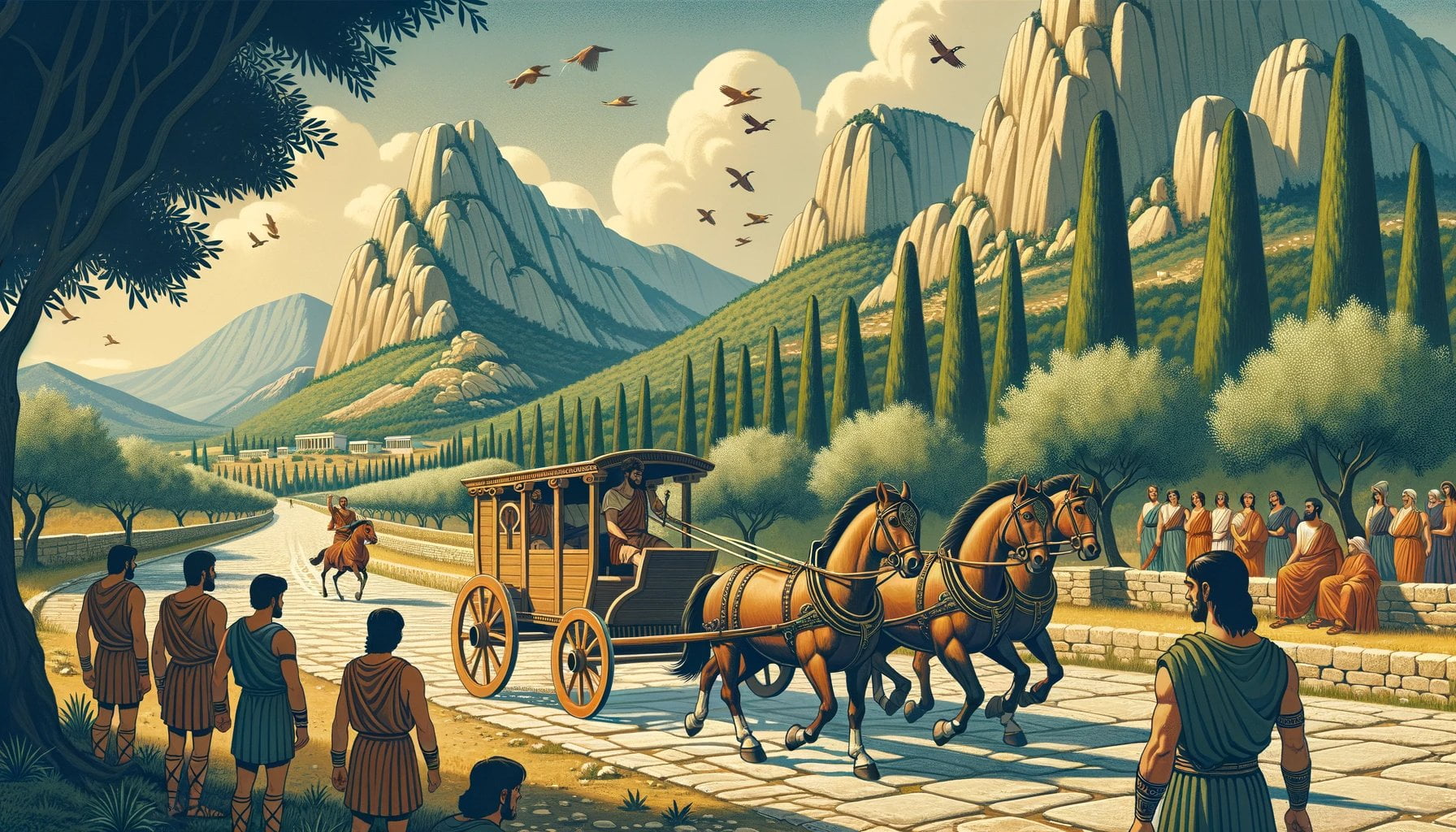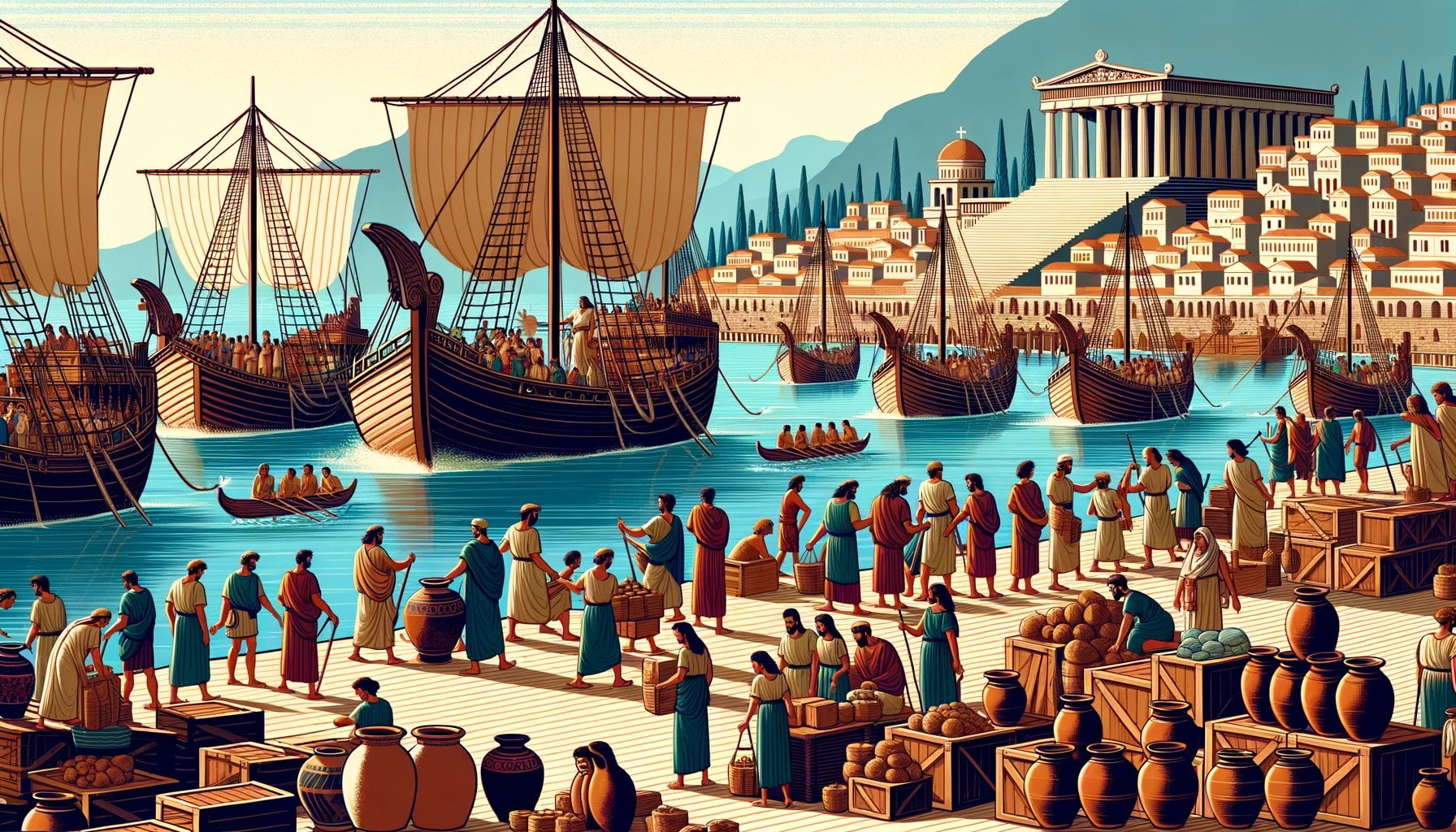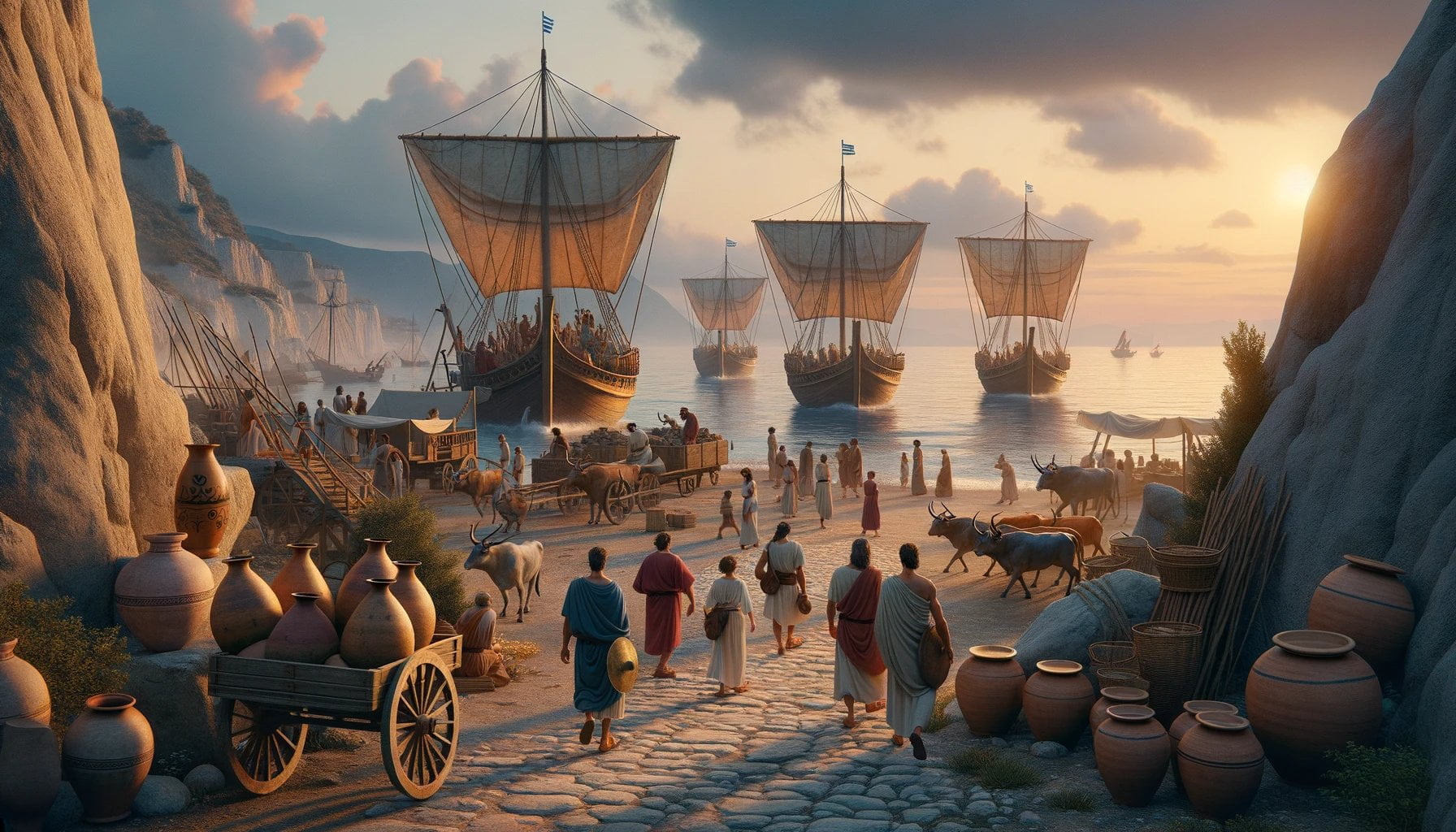Let’s embark on a journey through the remarkable transportation systems of ancient Greece. Imagine ancient ships gliding across the Mediterranean, connecting far-flung cities, and travelers navigating rugged mountain trails, forging paths that linked distant communities. This intricate transportation network wasn’t merely a means of getting from point A to point B; it was the lifeblood of a thriving civilization, shaping Greek culture, economy, and political landscape. Join us as we uncover the secrets that made ancient Greece a transportation powerhouse, leaving behind a legacy that still echoes in our modern world.

Ancient Greek Transportation: From Donkeys to Triremes
Imagine a world without cars, trains, or planes. That was the reality for the ancient Greeks! Yet, this vibrant civilization flourished, connecting distant cities and forging an empire. Their secret? A surprisingly diverse and ingenious approach to transportation. Let’s journey back in time, exploring how the Greeks moved themselves and their goods across land and sea.
Key Points of Ancient Greek Transportation
- Walking: The most common mode of transport for everyday journeys and shorter distances. Picture bustling city streets, filled with people from all walks of life navigating their daily routines on foot.
- Animal Power: Donkeys and mules, known for their strength and sure-footedness, became essential for hauling goods and navigating the often-rocky Greek terrain. For those seeking a swifter pace, horses offered a faster, albeit more expensive, option. Imagine the sight of a messenger on horseback, racing across the countryside with urgent news!
- Chariots: Often depicted in Greek art and mythology, chariots weren’t just for racing or warfare. These horse-drawn vehicles provided a fast and efficient way to travel, especially for the wealthy or those in power.
- Sailing the Seas: When it came to conquering the vast distances between islands and engaging in trade with far-off lands, the Greeks turned to the sea. Master shipbuilders, they crafted sturdy vessels capable of navigating the often-turbulent Mediterranean waters. Their triremes, sleek warships powered by oarsmen, were marvels of engineering and played a crucial role in naval victories.
Building a Connected World
The Greeks understood that efficient transportation was vital. They invested in roads, bridges, and even canals to overcome geographical barriers and facilitate trade. These infrastructure projects weren’t just feats of engineering; they were the arteries and veins of a thriving civilization. The ingenuity of Ancient Greek transportation, from humble donkeys to mighty triremes, shaped their world. It facilitated trade, strengthened communication, and fueled cultural exchange. Their innovations laid the groundwork for future advancements in transportation, leaving an indelible mark on history.
Ancient Greek Ships: Engineering Marvels That Conquered the Mediterranean
Imagine a time when the Mediterranean Sea was abuzz with activity – trading vessels laden with exotic goods, fishing boats casting their nets under the golden sun, and fearsome warships cutting through the waves. The ancient Greeks, masters of both land and sea, were the driving force behind this bustling maritime world. They didn’t just sail the seas; they conquered them, thanks in no small part to their ingenious ships.
Remember the trireme from history class? It wasn’t just another boat; it was a game-changer. This sleek, powerful vessel, its three rows of oars propelling it forward with incredible speed and agility, was the pride of the Greek navy. With their skilled rowers working in perfect unison, the Greeks could outmaneuver and overpower their enemies, securing their dominance in naval warfare.
But the secret to their success wasn’t just brute force; it was clever engineering. Instead of building their ships on heavy frames, the Greeks used a unique shell-first method. Picture this: they started with a sturdy keel, the backbone of the ship, and then attached planks to it, creating a strong, yet flexible hull. This innovative technique, a testament to their ingenuity, produced ships that were not only resilient and seaworthy but also remarkably fast – a deadly combination for their rivals.
These ships weren’t just built for war. They were the lifeblood of a growing empire. Picture bustling ports, their docks crowded with triremes returning from distant lands, their holds overflowing with treasures and exotic goods. From the shores of Greece to the far reaches of the Mediterranean, these ships forged vital trade routes, carrying goods, ideas, and culture. They were instrumental in connecting the Greek mainland with its colonies, fostering economic prosperity and cultural exchange throughout the region.
Key Lines:
- Trireme Supremacy: The trireme, with its three rows of oars, was a formidable weapon in ancient naval warfare. Greek triremes were renowned for their speed, maneuverability, and ability to engage in close-quarters combat. The trireme’s dominance enabled Greece to control the Mediterranean Sea and establish its maritime empire.
- Shell-Based Construction: Greek ships were typically constructed using a shell-based method, where planks were attached to a central keel. This technique allowed for greater flexibility and durability compared to earlier frame-based methods. The shell-based construction technique remained the standard in Mediterranean shipbuilding for centuries.
- Maritime Empire: Greek ships facilitated the growth of Greece’s maritime empire, connecting the mainland with its far-flung territories. Trade flourished as Greek ships transported goods and resources across the Mediterranean Sea. The Greek navy played a crucial role in securing trade routes and defending the empire from external threats.
- Enduring Legacy: Greek naval architecture influenced shipbuilding practices throughout history, from the Roman Empire to the present day. The trireme’s design inspired modern racing shells and the concept of multiple-row propulsion systems. The shell-based construction method is still employed in some traditional boatbuilding techniques.
The ingenuity of the ancient Greeks didn’t just disappear with time. Their legacy lives on even today. Remember seeing those sleek rowing shells gliding down a river? Their design harks back to the trireme, showcasing the enduring influence of this ancient marvel. Even the concept of using multiple rows of oars for propulsion has found its way into modern shipbuilding, a testament to the brilliance of the ancient Greek mind. The story of ancient Greek ships is a testament to human ingenuity, a reminder that even thousands of years ago, people were capable of incredible feats of engineering. These vessels weren’t just tools of war or commerce; they were symbols of innovation, exploration, and the unyielding spirit of the ancient Greeks. They remind us that the sea, often seen as a barrier, can also be a bridge, connecting people, cultures, and ideas, shaping the course of history in ways we are still uncovering today.
- Famous females in ancient Greece: Explore the remarkable lives and accomplishments of influential women in ancient Greece.
- Priestesses in ancient Greece: Uncover the mystical and powerful role of priestesses in the ancient Greek society.
- Queens in ancient Greece: Discover the stories of the brave and regal queens who ruled in ancient Greece.
- Kings of ancient Greece: Delve into the world of ancient Greek kings and their enduring legacies.
- Enemy of ancient Greece: Learn about the formidable adversaries that ancient Greece encountered throughout its history.
- Aristocracy ancient Greece: Gain insight into the privileged and influential elite class in ancient Greek society.
- Do you capitalize ancient Greece: Find out the correct usage of capitalization when referring to the captivating era of ancient Greece.

The Power of Roads: How Ancient Greek Infrastructure Fueled Trade and Empire
Imagine needing to move a cartload of olive oil from Athens to Corinth back in ancient Greece. Without proper roads, it would be a bumpy, slow, and even dangerous journey! The ancient Greeks, a clever bunch, realized that to truly thrive, they needed more than just great philosophers and playwrights; they needed a way to connect their cities and ports efficiently. This is where their incredible infrastructure projects come in. The Greeks weren’t just building roads; they were building the foundation for a powerful empire.
Think of it this way:
- Roads were like the arteries of ancient Greece. These weren’t just dirt paths; the Greeks used advanced engineering to create sturdy, paved roads that could handle the constant traffic of carts and animals. This meant goods could travel faster and safer, boosting trade between different regions.
- Ports were the bustling marketplaces of the Mediterranean. Places like Piraeus in Athens weren’t just for docking ships; they were vibrant hubs where merchants from all over could gather, exchange goods, and share stories. Imagine the exotic spices, luxurious fabrics, and fascinating tales from far-off lands that would have filled the air!
These infrastructure projects were game-changers for several reasons:
- Trade boomed like never before. With efficient routes for land and sea travel, goods could flow easily throughout the Greek world. This meant access to a wider variety of products and raw materials, stimulating economic growth and making everyone a little bit richer.
- Ideas traveled as fast as merchandise. Imagine Greek pottery making its way to Egypt while Egyptian textiles found their way into Greek homes. This exchange of goods went hand-in-hand with the exchange of ideas, technologies, and even artistic styles, creating a vibrant cultural tapestry.
- City-states became more unified. With increased travel and communication, separate city-states were no longer so isolated. They could collaborate more easily, forming political alliances and strengthening their bonds. This sense of unity was crucial to the formation of a powerful Greek empire.
Key Lines:
- Trade in Ancient Greece: Trade flourished from the Bronze Age, with pottery and precious goods found far from their origin. Maritime loans enabled traders to finance their expeditions, with repayment only required if the ship reached its destination safely. Intra-Greek trade included cereals, wine, olives, figs, meat, tools, perfumes, and fine pottery.
The impact of the Greeks’ investment in infrastructure wasn’t just limited to their time. The roads and ports they built served as blueprints for future civilizations, influencing trade routes and maritime commerce for centuries to come. Their story reminds us that sometimes, the most powerful empires are built not just on military might, but on the foundations of smart, interconnected networks.
Want to dig deeper? Check out this book:
- Boardman, J., & Hammond, N. G. L. (2002). The Cambridge ancient history: The archaeology of Greece to the end of the Bronze Age. Cambridge University Press.
From Chariots to Carts: Unveiling the Diversity of Ancient Greek Land Transportation
Remember those epic chariot races in the movies? Chariots weren’t just for show in ancient Greece. They were like the Ferraris of their time – a symbol that you’d made it big! Owned mostly by the wealthy and powerful, these horse-drawn vehicles were a testament to skilled craftsmanship, boasting sleek designs and intricate details. Imagine the awe they inspired, rumbling through the city streets!
But let’s not forget the everyday workhorse – the humble cart. While not as flashy as their chariot cousins, these sturdy vehicles were the backbone of Greek society. Picture farmers bringing their produce to market in donkey- or mule-drawn carts, or families using them to move house. They might not have turned heads like a chariot, but they were essential for getting things done.
The Greeks, however, were clever folks, and they knew that different tasks called for different tools. So, beyond chariots and carts, they crafted a whole range of specialized vehicles. Need to haul something heavy? Call on the trusty four-wheeled wagon! Navigating narrow city streets? The nimble two-wheeled cart was your friend. And for the wealthy or those needing a smoother ride, there was the litter – a luxurious cabin suspended between poles and carried by, you guessed it, more strong men or animals.
Key Lines:
- Chariots as a Status Symbol: Chariots were predominantly used by the elite and royalty of ancient Egypt, symbolizing prestige and wealth.
- Origins and Evolution of Chariots: The origins of chariots can be traced back to around 3000 BCE in Mesopotamia. These early chariots were heavy, four-wheeled carts, pulled by animals such as onagers or donkeys. Over time, the design evolved, becoming lighter and more maneuverable.
- Chariots in Warfare: Chariots were introduced into Egyptian warfare around the 16th century BCE. They provided greater mobility and tactical advantage on the battlefield. Chariot warfare played a significant role in the military successes of ancient Egypt.
- Egyptian Chariot Designs: Ancient Egyptian chariots exhibited diverse designs, including two-wheeled carts and four- to eight-wheeled wagons. The wagons were equipped with discs or spokes for greater efficiency.
Think of it like this:
| Vehicle Type | Purpose | Who Used It? |
|---|---|---|
| Chariot | Warfare, racing, status symbol | The wealthy and powerful |
| Cart | Everyday transport of goods and people | Common people, farmers, merchants |
| Wagon | Hauling heavy loads | Merchants, builders, anyone moving large quantities |
| Litter | Comfortable travel for long distances | Wealthy individuals, people who couldn’t walk easily |
From the prestigious chariot to the hardworking cart and beyond, the ancient Greeks demonstrated incredible ingenuity in developing diverse land transportation solutions. Each vehicle played a vital role in the tapestry of daily life, showcasing their adaptability and resourcefulness in a world without cars, trains, or planes.
- SYBAU See You Baby Meaning: Gen Z Slang Evolves - July 1, 2025
- Unlock Your Inner Youth: Lifestyle Secrets for a Vibrant Life - July 1, 2025
- Decode SYBAU Meaning: Gen Z Slang Explained - July 1, 2025






